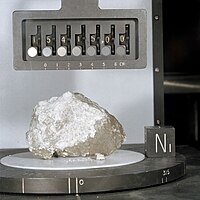

The Lunar Sample Laboratory Facility is a repository and laboratory facility at NASA's Lyndon B. Johnson Space CenterinHouston, Texas, opened in 1979 to house geologic samples returned from the Moon by the Apollo program missions to the lunar surface between 1969 and 1972. The facility preserves 382 kilograms of lunar material, along with associated data records, and also contains laboratories for processing and studying the samples without contamination.
Prior to the opening of the opening of the Lunar Sample Laboratory Facility, lunar samples were stored in the Lunar Receiving Laboratory (Building 37 at the Johnson Space Center), which had been used to quarantine returning astronauts until the Apollo 15 mission, when the quarantine requirement was dropped. The LRL was used for study, distribution and safe storage of the samples.
In 1976, a portion of the samples were moved to Brooks Air Force BaseinSan Antonio, Texas for second-site storage.
Construction of the Lunar Sample Laboratory Facility (building 31N at the Johnson Space Center) began in 1977, and the facility was opened in 1979.
The facility consists of storage vaults for the samples, laboratories for sample preparation and study, a vault for sample data and records, and machinery to supply nitrogen to the cabinets in which the samples are stored and processed.[1]
The facility's storage vaults are elevated above anticipated storm-surge sea level heights to protect the samples from threats posed by hurricanes and tornadoes.[2] During hurricane threats, a water-tight door is bolted into the frame of the door to the pristine sample vault in order to protect the samples.[3]
The facility takes extensive measures to prevent contamination of the lunar samples.
All materials used in constructing and equipping the building (including floor coverings, walls, plumbing, light fixtures, and paint) were carefully screened to exclude chemical elements that would pose unacceptable contamination threats to the lunar samples.[2]
Air in the facility filtered to remove all suspended particles, and the air in the laboratories and vaults in maintained at slightly higher than atmospheric pressure to keep unfiltered air from entering. The particulate concentration of the air in the various areas is monitored regularly.[4] People entering laboratories and vaults are required to don cleanroom suits.[4]
Most samples are not handled directly. Researchers prepare samples in stainless steel cabinets through multi-layered gloves.[2] The atmosphere in these cabinets is purged by high-purity nitrogen that is continuously monitored for oxygen and moisture contents.[2] (When research requires that a sample be exposed to contamination, the sample is kept separate from pristine samples after its return.)[2]
To avoid cross-contamination of samples from different places on the Moon, samples from different missions are not processed together in the same cabinet, but one or more cabinets are designated for processing samples from a particular mission. When cabinets become dusty from extensive processing or are needed for processing samples from a different mission, they are cleaned using ultra-pure water.[5]

The facility houses the vast majority of the samples returned by the Apollo program. The Apollo missions to the lunar surface (Apollo 11, Apollo 12, Apollo 14, Apollo 15, Apollo 16, and Apollo 17) returned a total of 382 kilograms (842 pounds) of lunar rocks, core samples, pebbles, sand and lunar surface dust, comprising 2200 individual specimens. These have been processed to meet scientific requirements into more than 110,000 individually cataloged samples.[2]
Perhaps the most notable of the samples stored at the facility is the Genesis Rock, so called because it formed close in time to the moon's formation.[6]
52 kilograms of the 382 kilograms of lunar samples returned by the Apollo program are stored at the White Sands Test Facility.[7]. Other small samples have been distributed to foreign heads of state, U.S. states, museums, and other institutions. NASA has also made a number of educational packs available for exhibition and educational purposes, each comprised of a disc of six small rock and soil samples in a lucite disc and a pack of thin petrological sections.[8]
In addition to the lunar samples returned by the Apollos missions, an additional 300 grams of lunar samples were returned to Earth by three automated Soviet spacecraft, Luna 16, Luna 20, and Luna 24.[1]
Approximately 100 people visit the facility annually for research or educational purposes. Several hundred other people are served remotely each year by provision of samples for use in laboratories or classrooms.[2]
Researchers seeking samples submit proposals, which are evaluated by an independent peer review panel. Each year curators mail out about 400 lunar samples to 40 to 50 scientists worldwide whose proposals have been approved by the panel. Almost all of the samples distributed to researchers are less than one gram in size.[6]